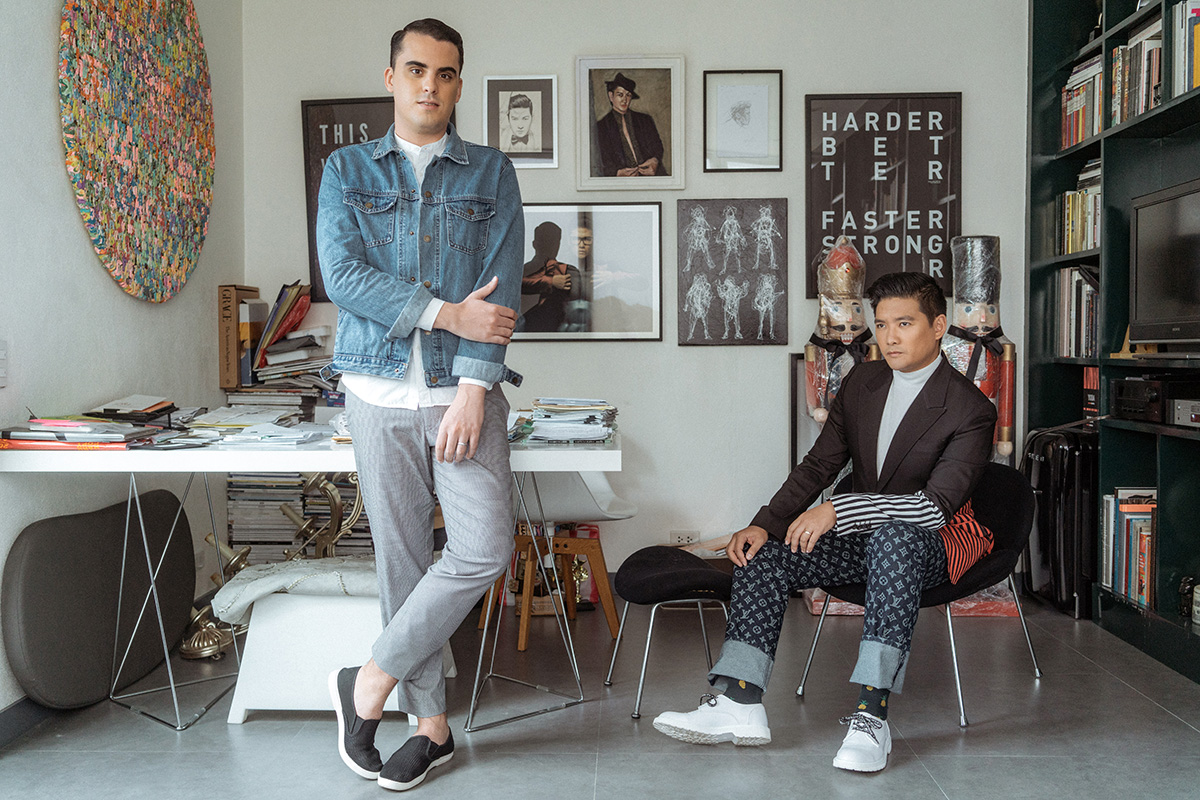One year. Nine trips to Paris. Twenty-six suppliers. Two hundred ninety-eight people working on the day of the event. That’s what it took for Tim Yap and Javi Martinez to turn Vicki Belo and Hayden Kho’s wedding into a euphoric experience.
“Of course there were challenges, but it was worth it,” says Martinez.
And yet it’s also a pensive exploration of planning and designing events, and how a startup like Yaparazzi Events + PR sits within a global events industry.
“We communicated with suppliers from all over the world. There was a language barrier,” adds Yap, “There were always barriers but we didn’t treat them as barriers. We came out with something to be proud of not just by the client but also by Filipinos.”
“It was the first time in the history of Opera Garnier that it was closed by an Asian agency,” reveals Martinez matter-of-factly.
And before anyone asks, yes, the couple are friends with Belo, but it doesn’t tell you everything you need to know about their frame of mind when the Belo Medical Group founder first hired them to mount her company’s 25th anniversary in 2015, then daughter Cristalle Henares’s wedding to Australian hotelier Justin Pitt in 2016, and then her own wedding to fellow doctor and entrepreneur Hayden Kho last year.
“Our skill sets are very different, how we see things, and our visions complement each other,” says Tim Yap.
There’s a lot more nuance to Yap and Martinez as a subversive events and public relations firm than their impressive network and flair for opulence would suggest. When you take out all of the undertones and strip them down to the basics, their approach is different—how they’re able to shape a fantasy out of a brand and retain its values, how they’re adept at redirecting the energies of private gatherings. They don’t simply react to what a brand or client wants, but they’re also not aggressors. In that sense, the couple has managed to land top clients, create artistic events, and give people a reason to attend—all while directly communicating an idea, cause, or message at point-blank range and on their own terms.
On closer inspection, Yap and Martinez are an oddity—the perfect partnership when it comes to the brutal events and public relations industry.
“Our skill sets are very different, how we see things, and our visions complement each other,” says Yap. [The company] started when Javi would actually take care of the nitty-gritty of my birthday parties. And because our guest list was so diverse, we would get clients from those birthday parties.”
“What we do is events production, so we provide PR and marketing services for those same events. We do road management for international artists and we do marketing for specific brands,” says Martinez. “He takes care of all the marketing and PR side of the events and what I do more is the production, the event design, the staging.”
It isn’t an uncommon scenario to find events production companies that also provide additional services for those events. Yet what does it really mean to be in events these days?
“You need to listen a lot to the client and to see what is on their mind,” says Javi Martinez. “[Perhaps] they don’t like your idea at the beginning but once you listen to them and find why they don’t like that idea, maybe you are able to tweak it a bit.”
The basics
“For us, you should be able to dream. You should be able to sit down with the brands and clients and listen to what they desire, [understand] how they want it to feel like. And then supply everything to make it concrete,” says Yap.
“You need to listen a lot to the client and to see what is on their mind,” adds Martinez. “[Perhaps] they don’t like your idea at the beginning but once you listen to them and find why they don’t like that idea, maybe you are able to tweak it a bit.”
But Martinez is quick to note that everything simply starts from an idea before you can actually go into the details of the tasks and activities related to the event, which usually includes carrying out research; searching for—or in their case, building—a venue; creating a site design; deploying invitations; planning food, transportation, entertainment, or even accommodations; managing event personnel; supervising ingress and egress; and conducting evaluations.
Relationship of space and emotion
Yet for all these guidelines, Yap believes that event planners require a certain expertise, a stronger hand than most, to “see the invisible to achieve the impossible for other people.”
A good example of this is the relationship of the space and the brand. After all, when creating events, it’s about the connection between a tangible area and the brand values. How do you visualize, identify, and build a specific brand’s identity into it?
When creating events, it’s about the connection between a tangible area and the brand values. How do you visualize, identify, and build a specific brand’s identity into it?
“One thing common that we always do is inject fun,” says Yap. “If you go to an event and you’re bored, then nothing will get retained. A lot of people do it, but it takes magic to transport a venue into something that carries out the message. That the people who attend the event get to imbibe the message of the brand. Unless it’s super serious.”
“It’s not just about the details,” says Martinez. “You have a lot of challenges when it comes to venues. You have to consider something as small a detail as an electrical load, the height of the ceiling, how many kilos can you hang from a hanging point, how big is your door so you know how big your elements can be or if you have to break it down. Sometimes, venues get scratched out because they are difficult, they have too many rules, they don’t collaborate. Or they don’t fit enough people.”
Be innovators
Another problem that hasn’t been lost in the minds of the couple is the regular lack of innovation. Traditionally, brands tend to stick to what the two call “copy-paste” concepts. “Sometimes, for them, it’s easier to just copy the same [concept] as last year,” reveals Martinez. However, while the industry may take its time to enter a new era, Yap and Martinez, who have become increasingly vocal about reshaping the events landscape, are happy to go through the growing pains of dissecting the minds of brands and clients alike.
“It comes into our experience to convince them and show them the benefits of doing something different but still trying to deliver the same feelings and objectives they have in mind,” says Martinez, indicating that people and organizational skills, time management, flexibility, and passion aren’t the only qualities required from event planners. This partly explains their preoccupation with and proclivity for travel—to find new textiles and equipment to bathe brands in, to leave the idea of familiarity, and punctuate phone launches with quality that pay more attention to the image they wish to cultivate.
Embrace mistakes as they happen
But no matter how much planning you do, you can’t control everything. You can, however, reduce the risks if you do your homework. Yap points out that Martinez’s no-nonsense instinct ranks among one of the reasons why he chalks up mistakes as learning experiences but believes that “if there’s a mistake, you do something about it, right there. An event is like a performance, if there’s a blooper, you make sure it’s not seen and then you make up for it.”
No matter how much planning you do, you can’t control everything. You can, however, reduce the risks if you do your homework.
“Javi is the type who always has options, but ‘mistakes’ that have happened, ended up becoming better for the event. [For example] we were praying it doesn’t rain, but it rained so we had no choice but to transfer to a smaller venue,” says Yap. Sure, it was bothersome, but circumstances like these force you to be more creative and rely on a willingness to “go with the flow.”
“Plus, people thought that was the plan,” speaks Martinez. “They think everything is how it’s supposed to be. Sometimes those mistakes, we are the only ones who notice it. Sometimes Tim doesn’t even notice them.” Still, investing in backups and options is crucial, especially if you’re new to the business. Consider the non-monetary costs—and benefits—it would take to transport guests from point A to point B due to inclement weather. It would feel revolutionary and look as if you have a deep understanding of events in various contexts.

The price you have to pay
While the Philippine event scene still has plenty of room for improvement, making it in the events industry also means coming to terms with a hazardous tug-of-war plaguing practically every business: price.
Reports released in 2018 by event management platform EventMB found that dwindling budgets are the biggest challenges of event planners followed by “finding sponsors and attendee numbers.”
And for many agencies and firms, the process of winning accounts is overshadowed by how low you can go instead of the value of your proposition. It’s a narrative that, in the Philippines, has become the norm.
“In the beginning, we had to bid,” says Yap. “There would be a final three and we’d be there. But now we don’t bid anymore.”
“Can I tell you why?” asks Martinez. “When people or companies ask you to bid, they ask you to bid on price. Who can make it cheaper? They don’t bid on creativity or execution.”
“In the end, if it’s based on price, you churn out work that’s price-based,” confesses Yap. It’s a clear non-negotiable manifesto the two adhere to. But in the wake of setting out certain demands, perhaps Yaparazzi is unequivocally turning the table on its head. A role reversal of sorts. Now, they are hoping the shift is underway.
Reports released in 2018 by event management platform EventMB found that dwindling budgets are the biggest challenges of event planners followed by “finding sponsors and attendee numbers.”
Says Martinez, “I guess it’s not just learning all the time but we are also trying to deliver clients to understand that there are other ways to do things. Most of the time, when we work with a client, we are open with them, we show them the way we do things so they can actually learn.”
“After they work with us, they know what kind of work we churn out so we don’t have to bid anymore. Because I don’t want to waste my time. It’s better to focus your work on clients who understand. We don’t need to keep trying to prove ourselves because we’ve already proven ourselves,” says Yap.
Perhaps this is best thing that Yaparazzi could provide the industry. There is an undeniable sassiness to the way they do things, but it comes from a position of strength that could eventually bolster the industry as a whole and support aspiring event planners and PR professionals. This newfound command of the I-know-what-I-know school of thought without searching for approval makes you wonder just what they are capable of doing next, existing and operating in the interesting gray area they created for themselves.
Originally published in F&B Report Vol. 15 No. 4





